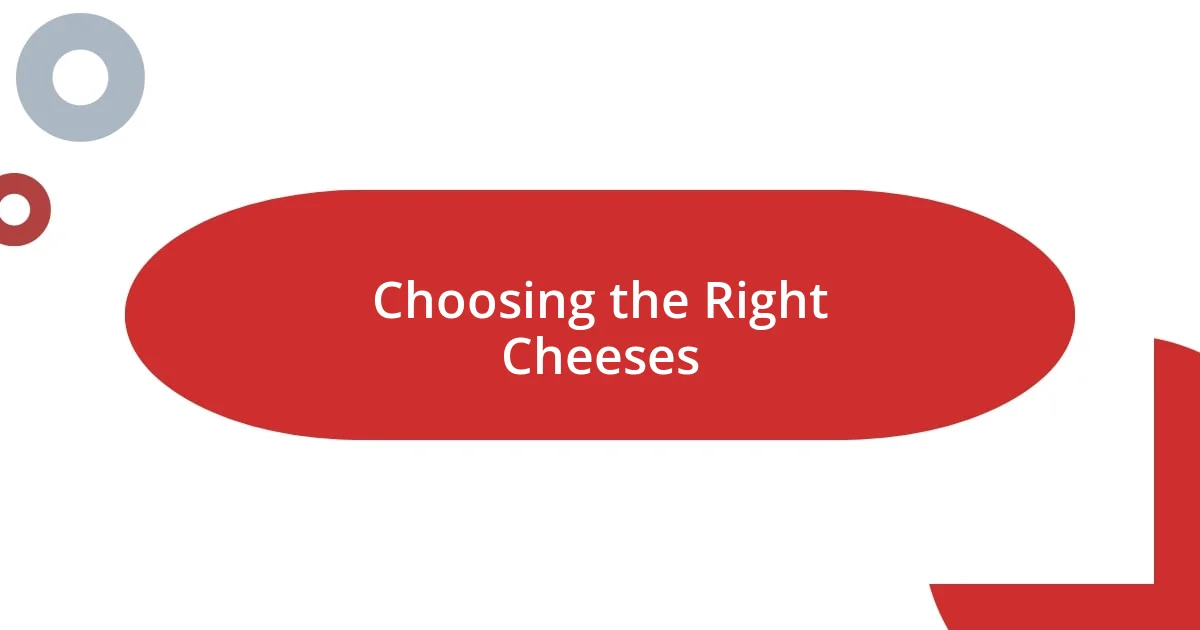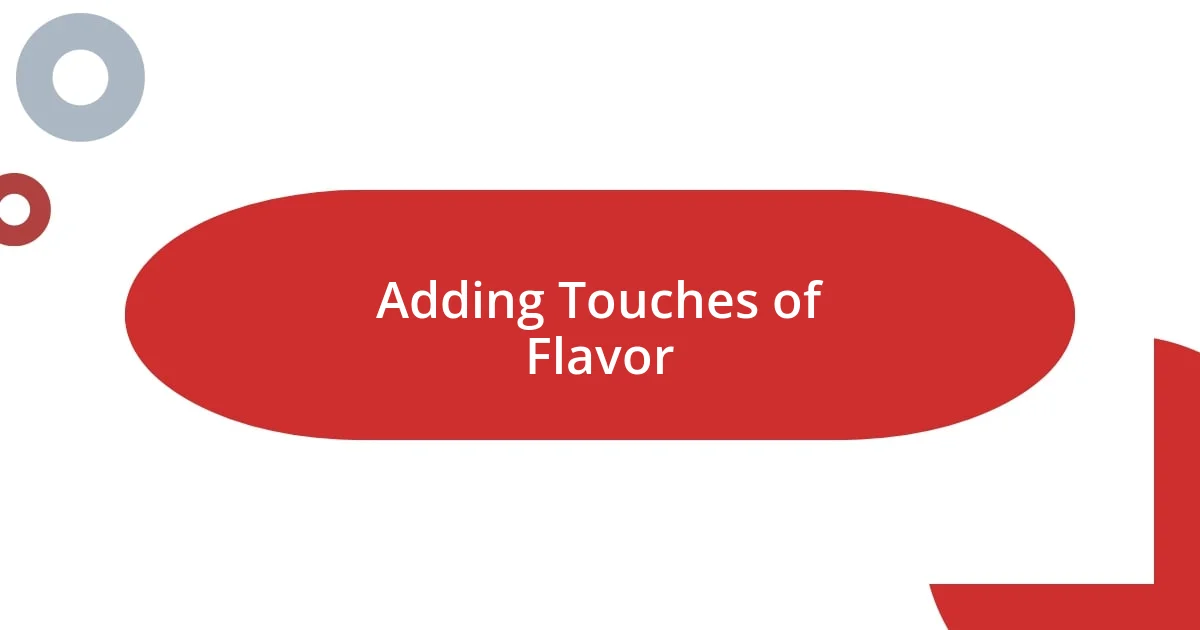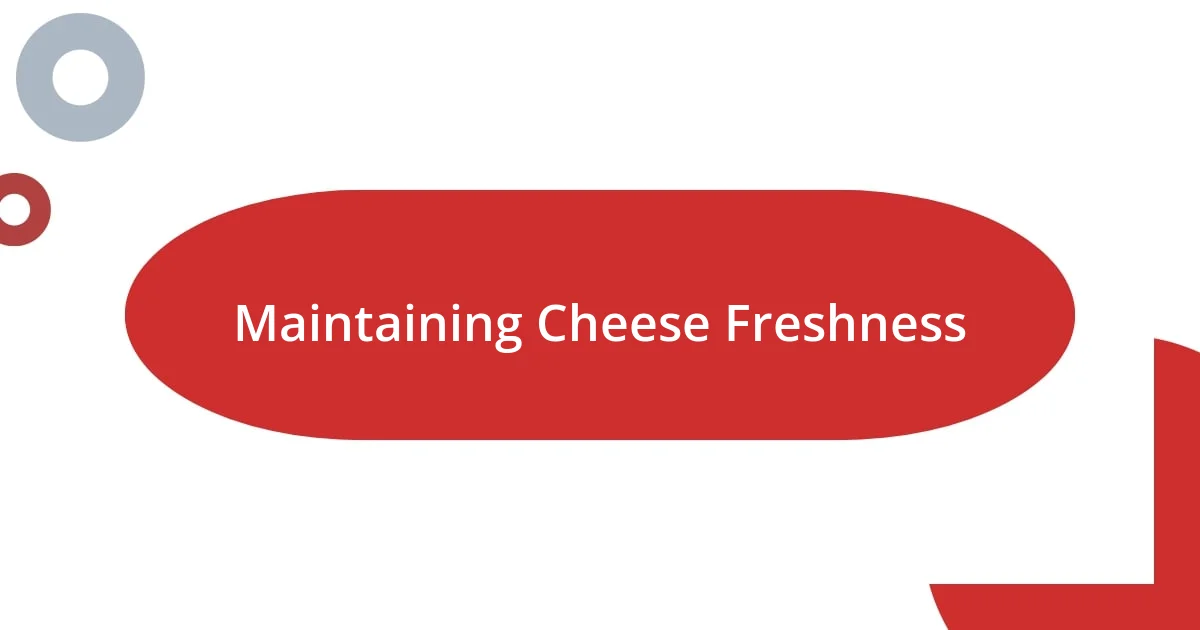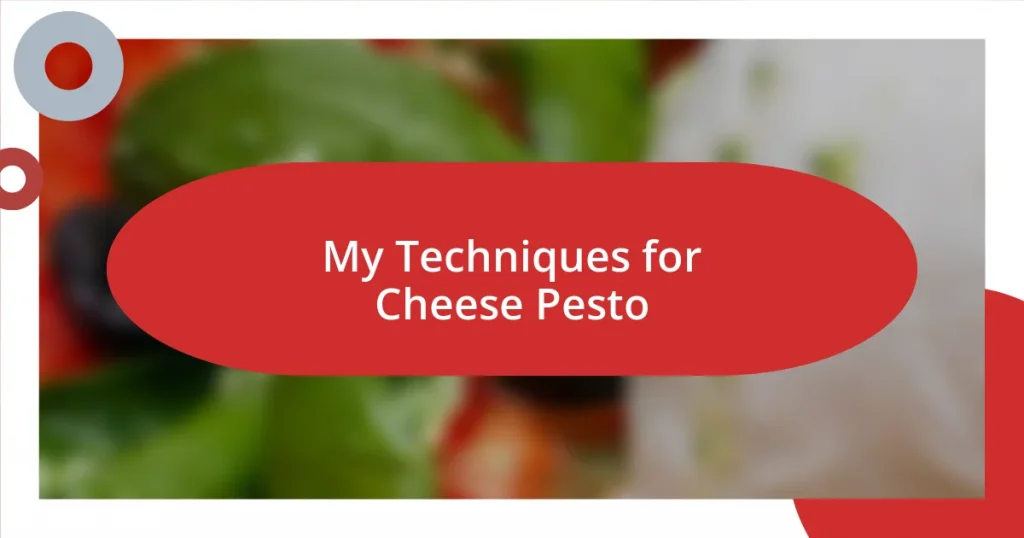Key takeaways:
- Curate a diverse selection of cheeses, balancing flavors and textures while sharing their stories to enhance the cheese platter’s experience.
- Incorporate complementary ingredients, such as fruits, nuts, and spreads, to create a harmonious and inviting cheese platter.
- Focus on presentation by arranging ingredients aesthetically, using color and texture contrasts, and serving cheeses at room temperature for the best flavor.

Choosing the Right Cheeses
When I choose cheeses for a platter, I always aim for a variety that reflects different flavors and textures. A creamy Brie pairs beautifully with a sharp cheddar, and I find that the contrast keeps my guests excited and intrigued. Have you ever noticed how the rich creaminess of a blue cheese can elevate a simple cracker?
I remember the first time I combined a tangy goat cheese with sweet figs. The reaction was priceless! People were surprised at how these flavors danced together, which is something I always keep in mind when curating my cheese selection. It’s these surprising combinations that spark the most conversation, don’t you think?
I also consider the cheese’s origin and story. A local artisanal cheese can make your platter not just delicious but also meaningful. Sharing a bit about where the cheese comes from or how it’s made adds a personal touch that makes the experience memorable. Isn’t it exciting to create a cheese platter that not only pleases the palate but also tells a story?

Selecting Complementary Ingredients
When selecting complementary ingredients, balance and contrast are key. I often think about how adding fruits can elevate the entire experience. For instance, pairing tangy apple slices with a salty cheese creates a delightful taste explosion. I once brought a cheese platter to a gathering, featuring sharp aged Gouda and juicy, sweet pears. To my surprise, the combination was a hit! Guests kept returning for more.
Here are some ingredients I recommend pairing to achieve a harmonious cheese platter:
- Nuts: Almonds or walnuts add a satisfying crunch.
- Fruits: Dried fruits, such as apricots or fresh berries, provide a sweet contrast.
- Spreads: Honey or fig jam can enhance flavors beautifully.
- Crackers and Bread: A variety of textures from crisp crackers to soft baguette slices is essential.
- Pickles or Olives: These add a savory touch that balances richer cheeses.
I believe that each ingredient should play a part in the overall composition, creating a memorable experience for everyone.

Arranging the Platter Aesthetically
When I arrange a cheese platter, I always try to think of it as a canvas. The colors and shapes of the ingredients can create visual excitement that draws people in. For instance, I once used vibrant red strawberries next to a pale Brie, and the contrast was striking! Placing items in clusters instead of straight lines can evoke a sense of abundance, making the platter feel inviting. Have you ever noticed how a little asymmetry makes a design more appealing?
Creating movement is another aspect I pour my creativity into. I like to layer items like cheeses, fruits, and nuts so that the eye travels across the platter. Picture a thick wedge of blue cheese artfully placed next to a cascade of sliced apples. This invites your guests to explore the platter, one delightful bite at a time. I find that arranging in a spiral or circular pattern often adds a dynamic flow. Just imagine guests gravitating toward the centerpiece, eager to indulge!
I also engage with textures—I believe they play a crucial role in aesthetics. Combining a soft cheese with crunchy nuts and creamy spreads gives each portion a different tactile experience. Once, I arranged a platter where guests could visually and physically dive into the variety. It intrigued everyone and led to delightful conversations about which combinations they enjoyed the most. This is what makes a cheese platter not just food but an experience.
| Aspect | Tip |
|---|---|
| Color Contrast | Use a mix of vibrant and neutral colors. |
| Asymmetry | Create clusters instead of straight lines. |
| Movement | Arrange in spirals or circles to invite exploration. |
| Texture Variety | Combine soft, crunchy, and creamy elements for interest. |

Adding Touches of Flavor
One of my favorite ways to add a splash of flavor is by incorporating fresh herbs. A sprinkle of rosemary or mint can completely transform the profile of your cheese platter. I remember hosting a casual get-together where I included basil on top of a fresh mozzarella along with cherry tomatoes. The guests were intrigued; they couldn’t believe such simplicity could yield such an elegant burst of flavor. Have you ever noticed how herbs can elevate even the most basic of ingredients?
I also love experimenting with flavored salts or spiced oils. There was a time when I drizzled chili-infused olive oil over creamy goat cheese, and the result was nothing short of stunning. The heat from the oil provided warmth that harmonized beautifully with the cheese’s tanginess. It created an unexpected yet delightful flavor contrast that had everyone talking about it long after the evening ended. So, why not think outside the box? It can lead to fantastic flavor discoveries.
Lastly, one of my go-to tricks is incorporating assorted dips. I often prepare a zesty yogurt-based dip or a savory pesto to accompany my cheese selections. The first time I served a lemon-garlic dip, it was a game changer. Guests couldn’t resist trying the dip with everything from Brie to aged cheddar. The idea is to create layers of flavor that invite people to discover their own perfect pairings. What’s more rewarding than watching your guests find joy in flavor combinations they never thought to try?

Incorporating Textures and Colors
Incorporating a mix of textures and colors can truly elevate your cheese platter, creating an inviting visual and tactile experience. For me, it’s like painting a picture on a plate. When I combine a creamy Camembert with the crunch of almonds and the juicy burst of cherry tomatoes, it’s not just about taste; it’s about the entire sensory experience. Have you ever craved the thrill of different textures all at once?
I also love playing with color; it adds an artistic element that captures attention. The time I arranged a platter with deep purple figs next to bright green grapes was pure magic. The vibrant hues not only made the platter visually stunning but also sparked curiosity in my guests. Each color tells a story and invites exploration. The bright visual contrasts are not just for show; they can guide people to taste combinations they may not have considered. What’s more satisfying than watching someone’s eyes light up as they discover a new favorite pairing?
Layering textures is key, too. Think about the creamy richness of a triple-crème cheese placed beside the rustic crunch of a seeded cracker. It creates a delightful contrast that enhances each bite. I once had friends over who were amazed at how blending such contrasting textures could transform their experience. You can almost feel the excitement bubbling in the air as people dive into the platter, eager to uncover new flavors. Why settle for simplicity when a tapestry of textures can invite your guests into a world of culinary delight?

Serving and Pairing Suggestions
When it comes to serving cheese, presentation is key. I like to offer my cheese at room temperature because it lets the flavors shine through. There was a gathering where I didn’t take out the cheeses ahead of time, and I could tell my guests missed out on the full flavor experience. Have you ever tasted a cheese straight from the fridge? It’s like listening to a song on low volume—you miss the energy and intricate notes that come alive when it’s warmed up just a bit.
Pairing is equally important; it’s all about balancing flavors and creating harmony on the palate. I often set out a selection of fresh fruits like pears or apples alongside robust cheeses like blue cheese. The first time I brought out ripe figs with a bold Cheddar, the sweet and savory collision left everyone raving about the unexpected match. It made me realize how certain pairings can evoke emotions and create memorable moments around the table. What’s your favorite flavor combination?
Lastly, don’t forget about drinks. A well-chosen wine or craft beer can elevate the entire experience. I remember introducing my friends to a crisp, dry rosé that perfectly complemented a rich Brie. It was as if they were suddenly transported to a vineyard in France with each bite and sip. It’s amazing how the right drink can enhance flavors and bring people closer together. What drinks have you tried that transformed your cheese platter into an unforgettable feast?

Maintaining Cheese Freshness
Keeping cheese fresh is pivotal to ensuring that each bite is as delightful as the last. I’ve found that tightly wrapping soft cheeses like Brie in wax paper helps maintain their moisture while allowing them to breathe—a lazy afternoon once turned into a rushed search for freshness after I discovered my soft cheese was sad and dry. Have you ever bitten into a crumbly cheese that just didn’t have that fresh, creamy texture? It’s such a letdown!
For semi-hard and hard cheeses, I like to wrap them in parchment paper before placing them in an airtight container. This method keeps them from drying out while preventing them from absorbing other odors in the fridge. There was a time when I neglected this step, only to be greeted by a rather pungent surprise when I reached for my beloved aged Gouda. It’s astonishing how the right storage can really elevate the cheese experience!
Another key factor is temperature; maintaining a consistent environment can make a world of difference. I typically aim to store my cheese at a temperature between 34-38°F (1-3°C) in a dedicated cheese drawer, if possible. The experience of forgetting about cheese in the regular fridge and pulling it out to find it almost frozen was a real eye-opener. Have you ever noticed how flavor can be completely muted when cheese is too cold? It becomes a different experience altogether! Remembering these small details transforms not just the cheese itself but the joy of sharing it with others.















